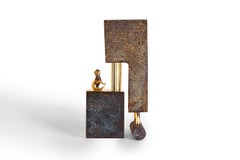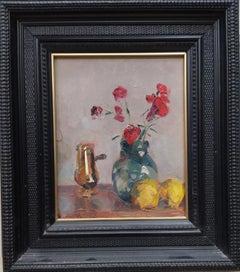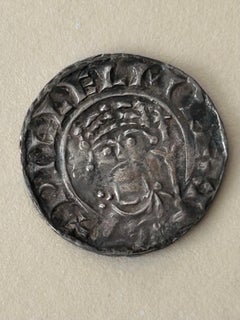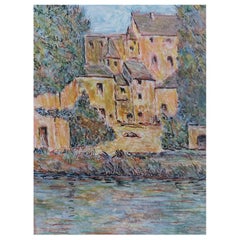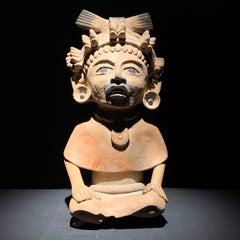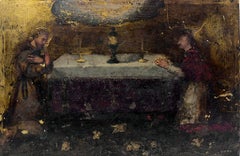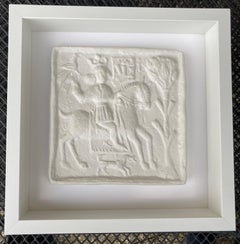15th Century and Earlier Art
to
43
90
28
19
12
16
Overall Width
to
Overall Height
to
7,524
21,075
157,861
233,659
1,956
2,250
4,856
6,371
5,767
13,149
19,335
25,592
17,935
13,706
5,358
17
5
4
3
3
2
1
1
42
39
2
89
45
44
38
36
26
21
17
11
11
9
6
5
5
5
5
4
4
4
4
43
32
27
26
26
5
3
2
2
1
16
4
90
73
Period: 15th Century and Earlier
20th Century French Modernist Cubist Painting, French Town
Located in Cirencester, Gloucestershire
Watercolor and ink French town buildings over a River
by Bernard Labbe (French mid 20th century)
original watercolor and ink on card
image size: 7.5 x 6 inches
card overall: 9.4 x 8....
Category
15th Century and Earlier Art
Materials
Acrylic
$234 Sale Price
30% Off
Veracruz Mexico Pre-Columbian ceramic Warrior figure sculpture
Located in Wilton Manors, FL
Figure of a Chanting Warrior
Ceramic with bitumen highlights
300-600 CE (Classic Period)
Mexico, Veracruz, possibly Nopiloa
Veracruz Culture
Pre-Columbian, Mexico, Vera Cruz culture...
Category
15th Century and Earlier Art
Materials
Ceramic
$6,000 Sale Price
50% Off
Pre-Columbian Colima Shaman terracotta figure vessel Mexican sculpture
Located in Wilton Manors, FL
Seated Shaman
Colima culture
Mexico
ca. 300 BCE - 300 CE
Pre-Columbian, West Mexico, Colima, ca. 300 BCE to 300 CE. A hollow-cast and highly-burnished terraco...
Category
15th Century and Earlier Art
Materials
Terracotta
Saint Albert Romuald Paint 15th Century Tempera on table Tuscan school Siena Art
Located in Riva del Garda, IT
Martino di Bartolomeo di Biago (Siena 1389 - 1434/35)
Pair of paintings S
AINT ROMUALD SAINT ALBERT OF MONTALCETO
Tempera on linen, on panel 132.3 x 51.8 cm 132.3 x 51.5 cm Fr...
Category
Old Masters 15th Century and Earlier Art
Materials
Tempera
$71,628 Sale Price
20% Off
Circa 1500 Italian Renaissance Oil Painting on Copper St. Francis of Assisi
Located in Cirencester, Gloucestershire
St. Francis of Assisi
Italian School, circa 1500
oil paint on copper, unframed
copper: 6.75 x 10 inches
provenance: private collection, Loire Valley, France
condition: for a work tha...
Category
Renaissance 15th Century and Earlier Art
Materials
Copper
Men on a Horse Medieval Tile Gypsum Cast
Located in Slovak Republic, SK
Gypsum cast-medieval tile, inspired from Central Europe. Adjusted in a frame, ready to hang or install.
Category
Gothic 15th Century and Earlier Art
Materials
Gesso
$293 Sale Price
20% Off
Tolosa (Toulouse); Leaf LXXI from Hartmann Schedel's Nuremberg Chronicle
Located in Middletown, NY
Woodcut on laid paper, 8 3/8 x 9 1/8 inches (212 x 233 mm), the full sheet. In excellent condition with text and portraits of Empedocles, Sapho, Zeuxis and others on the verso, as is...
Category
Old Masters 15th Century and Earlier Art
Materials
Ink, Handmade Paper, Laid Paper, Woodcut
Chimu Inca c.1500 Peruvian terra-cotta anthropomorphic face vase vessel Peru
Located in Wilton Manors, FL
Beautiful antique Peruvian face vessel. Chimu Inca, c.1500 Terracotta, measures h. 8 in., w. 4 7/8 inches. No repair or conservation.
Category
15th Century and Earlier Art
Materials
Terracotta
$720 Sale Price
60% Off
Costa Rican pre-Columbian sculptural figure ca. 1000-1500
Located in Wilton Manors, FL
Magnificent standing figure, Costa Rica, ca. 1000-1500. Carved volcanic stone. Measures 16.5 x 9 x 5.5 inches. Outstanding condition with no damage.
The figure represents a captured...
Category
15th Century and Earlier Art
Materials
Stone
Folio from Communion of Saints, Reading from the Book of St. Matthew.
Located in Fairlawn, OH
Readings from the "Communion of Saints": folio from an Italian Missal
Pigment on vellum
Mid 17th century
Provenance:
Otto F. Ege (1888-1951)
Phillip Duechnes Bookseller, New York, c. 1948
References And Exhibitions:
Otto F. Ege Box Folio 27
Ege describes these folios as: Epistolary (Epistolarium), Italy, Middle 15th century
Latin Text: Rotunda or Round Gothic Script, square rhetorical neumes
Sister folio are in the following rare book libraries:
Case Western Reserve University
Cincinnati Public Library
Cleveland Institute of Art
Cleveland Public Library
Denison University
Kent State University
Kenyon College...
Category
Old Masters 15th Century and Earlier Art
Materials
Ink, Vellum
Medieval enthroned Virgin and Child Sedes Sapientiae acephalic granit sculpture
Located in Norwich, GB
They may be damaged and battered, but real historic objects will always give you a sense of awe. Can you sense it, looking at this ancient carved granite which depicts, as it is call...
Category
Medieval 15th Century and Earlier Art
Materials
Granite
The Nativity of Christ
Located in Fairlawn, OH
Anonymous 15th Century Italian, Probably Milan area
The Nativity of Christ
Pigments, ink and gold leaf on vellum
Unsigned as is always the case with illuminated manuscripts
The Virgi...
Category
Old Masters 15th Century and Earlier Art
Materials
Pigment
Sandstone head of Buddha, Khmer, Angkor period, post-Bayon
Located in Wilton Manors, FL
Beautiful Khmer head of Buddha. Angkor period, style of the post-Bayon. 14th century. Carved sandstone. Height 12 5/8 inches, width 5 5/8 inches, profile 5 ...
Category
15th Century and Earlier Art
Materials
Sandstone
Antique Chinese Four Leaf Panel Hand-Painted Lacquer Screen
Located in Cirencester, Gloucestershire
Antique Chinese Four-Panel Lacquer Screen with Scenic Landscape
Description:
This exquisite antique Chinese four-panel lacquer screen is a remarkable example of traditional craftsma...
Category
15th Century and Earlier Art
Materials
Wood
$2,768 Sale Price
30% Off
Roundel depicting St. Catherine
Located in Fairlawn, OH
Unknown French Art and Workshop, Middle 15th century
Roundel depicting St. Catherine (?)
Gouache, ink gold wash and gold burnishing on vellum
Book of Hours folio attributed to the C...
Category
Old Masters 15th Century and Earlier Art
Materials
Gouache, Pigment
Gothic medieval Christian sculpture: smiling young bishop early carving France
Located in Norwich, GB
This 15th century bishop - sculpted ca AD1460 - has a smile on his lips and a benevolent presence. He is also something of an Adonis - one tends to forget that in the medieval churc...
Category
Gothic 15th Century and Earlier Art
Materials
Wood
Corpus Christi
Located in Wien, Wien
MUSEUM CORPUS CHRISTI
Spain/Catalonia or Asturias
Around 1250
Corpus hardwood, arms softwood
Remains of the original polychrome setting
Height 109.5...
Category
15th Century and Earlier Art
Materials
Wood
$48,000
French Modernist Cubist Painting a Summer Day's Sailing
Located in Cirencester, Gloucestershire
A Summer Day's Sailing
by Maurice Mazeilie (French, 1924-2021)
watercolor painting on artist paper, unframed
unsigned
stamped verso
A summer feel to this sunny image by a small harbo...
Category
15th Century and Earlier Art
Materials
Acrylic
$258 Sale Price
30% Off
One on a chariot Medieval Tile Gypsum Cast
Located in Slovak Republic, SK
Gypsum cast - medieval tile, from Central Europe. Adjusted in a frame, ready to hang or install.
Category
Gothic 15th Century and Earlier Art
Materials
Gesso
$265 Sale Price
27% Off
Romanesque Madonna - 1175/80
Located in Wien, Wien
ROMAN MADONNA
“Sedes Sapientiae”
Auvergne
Around 1175/80
Pine wood
Polychrome remains
Height 40 cm
This depiction of the Madonna is a masterfully carved, extremely early figure made...
Category
Gothic 15th Century and Earlier Art
Materials
Wood
Bildnis mit florentiner Hut. - Original Etching by Hans Thoma - 1900
By Hans Thoma 1
Located in Roma, IT
Bildnis mit florentiner Hut. is a beautiful black and white etching on cream-colored and laid paper, realized in 1898 by Hans Thoma.
Monogram and Date on p...
Category
Symbolist 15th Century and Earlier Art
Materials
Etching
Apotropäische Teufelsfigur
Located in Wien, Wien
APOTROPAIC DEVIL FIGURE
Romansh
South Tyrol or Grisons
Around 1120/50
Carved pine wood
Original version
Height 151 cm
This singular figure is a demonic, devil-like figure carved fro...
Category
15th Century and Earlier Art
Materials
Wood
French Modernist Cubist Painting Architectural Study
Located in Cirencester, Gloucestershire
Architectural Study of a Grand Stone Archway
by Maurice Mazeilie (French, 1924-2021)
watercolor painting on artist paper, unframed
unsigned
stamped verso
Beautifully composed work wh...
Category
15th Century and Earlier Art
Materials
Acrylic
$258 Sale Price
30% Off
French Modernist Cubist Painting Fishing Boats on the Coast
Located in Cirencester, Gloucestershire
Fishing boats by the Coast
by Maurice Mazeilie (French, 1924-2021)
watercolor painting on artist paper, unframed
signed lower right
stamped verso
Appealing painting in slightly overa...
Category
15th Century and Earlier Art
Materials
Acrylic
$258 Sale Price
30% Off
French Modernist Cubist Painting Village Work
Located in Cirencester, Gloucestershire
Village work
by Maurice Mazeilie (French, 1924-2021)
watercolor painting on artist paper, unframed
signed lower left
stamped verso
A figure works on the land by traditional village b...
Category
15th Century and Earlier Art
Materials
Acrylic
$370 Sale Price
30% Off
The Golden Calf - Nuremberg Chronicle, (528 Years Old)
Located in Santa Monica, CA
NUREMBERG CHRONICLE, 1493
THE GOLDEN CALF (THE CALF OF GOD) 1493
Woodcut. from "Liber Chronicarum." Printed by Anton Koberger text by Hartmann Sc...
Category
Old Masters 15th Century and Earlier Art
Materials
Woodcut
Madonna and Child, Polychrome Stucco Relief, workshop of Luca della Robbia.
Located in Pistoia, IT
Madonna and Child, polychrome stucco relief, workshop of Luca della Robbia. Second half of the 15th century.
Modeled as half-length, the Child holds his mother's veil in one hand, th...
Category
Medieval 15th Century and Earlier Art
Materials
Other Medium
Limestone Relief With Saint Georges, France 15th Century
Located in Milan, IT
Relief with saint Georges
France, 15th Century
limestone 26 x 20 cm (10 1/4 x 7 3/4 in) without base
Category
15th Century and Earlier Art
Materials
Limestone
Expertised Italian 14th Century Gold Ground on Panel Painting
Located in Roma, IT
Museum-quality gold ground painting from the Renaissance period by Smeraldo di Giovanni.
It depicts the “Virgin of the Roses” seated on a throne h...
Category
Renaissance 15th Century and Earlier Art
Materials
Tempera, Wood Panel
CRESCENT MOON MADONNA
Located in Wien, Wien
Master in the circle of Michael Pacher
(Mühlen ca. 1435 - 1498 Salzburg)
Salzburg
Around 1480
Carved limewood
Old polychrome version
Height 118 cm
This Madonna is an outstanding ex...
Category
Gothic 15th Century and Earlier Art
Materials
Wood
$168,000
The Resurrection of Christ
Located in New York, NY
Provenance:
with “Mr. Scheer,” Vienna, by July 1918; where acquired by:
Jindřich Waldes, Prague, 1918–1941; thence by descent to:
Private Collection, New York
Literature:
Rudolf Kuchynka, “České obrazy tabulové ve Waldesově obrazárně,” Památky archeologické, vol. 31 (1919), pp. 62-64, fig. 5.
Jaroslav Pešina, “K datování deskových obrazů ve Waldesově obrazárně,” Ročenka Kruhu pro Pěstování Dějin Umění: za rok (1934), pp. 131-137.
Jaroslav Pešina, Pozdně gotické deskové malířství v Čechách, Prague, 1940, pp. 150-151, 220.
Patrik Šimon, Jindřich Waldes: sběratel umění, Prague, 2001, pp. 166, 168, footnote 190.
Ivo Hlobil, “Tři gotické obrazy ze sbírky Jindřicha Waldese,” Umění, vol. 52, no. 4 (2004), p. 369.
Executed sometime in the 1380s or 1390s by a close associate of the Master of the
Třeboň Altarpiece, this impressive panel is a rare work created at the royal court in Prague and a significant re-discovery for the corpus of early Bohemian painting. It has emerged from an American collection, descendants of the celebrated Czech industrialist and collector Jindřich Waldes, who died in Havana fleeing Nazi-occupied Europe.
The distinctive visual tradition of the Bohemian school first began to take shape in the middle of the fourteenth century after Charles IV—King of Bohemia and later Holy Roman Emperor—established Prague as a major artistic center. The influx of foreign artists and the importation of significant works of art from across Europe had a profound influence on the development of a local pictorial style. Early Italian paintings, especially those by Sienese painters and Tommaso da Modena (who worked at Charles IV’s court), had a considerable impact on the first generation of Bohemian painters. Although this influence is still felt in the brilliant gold ground and the delicate tooling of the present work, the author of this painting appears to be responding more to the paintings of his predecessors in Prague than to foreign influences.
This Resurrection of Christ employs a compositional format that was popular throughout the late medieval period but was particularly pervasive in Bohemian painting. Christ is shown sitting atop a pink marble sarcophagus, stepping down onto the ground with one bare foot. He blesses the viewer with his right hand, while in his left he holds a triumphal cross with a fluttering banner, symbolizing his victory over death. Several Roman soldiers doze at the base of the tomb, except for one grotesque figure, who, beginning to wake, shields his eyes from the light and looks on with a face of bewilderment as Christ emerges from his tomb. Christ is wrapped in a striking red robe with a blue interior lining, the colors of which vary subtly in the changing light. He stands out prominently against the gold backdrop, which is interrupted only by the abstractly rendered landscape and trees on either side of him.
The soldiers’ armor is rendered in exacting detail, the cool gray of the metal contrasting with the earth tones of the outer garments. The sleeping soldier set within a jumble of armor with neither face nor hands exposed, is covered with what appears to be a shield emblazoned with two flies on a white field, somewhat resembling a cartouche (Fig. 1). This may be a heraldic device of the altarpiece’s patron or it may signify evil, referencing either the Roman soldiers or death, over both of which Christ triumphs.
This painting formed part of the collection assembled by the Czech industrialist and founder of the Waldes Koh-i-noor Company, Jindřich Waldes, in the early twentieth century. As a collector he is best remembered for establishing the Waldes Museum in Prague to house his collection of buttons (totaling nearly 70,000 items), as well as for being the primary patron of the modernist painter František Kupka. Waldes was also an avid collector of older art, and he approached his collecting activity with the goal of creating an encyclopedic collection of Czech art from the medieval period through to the then-present day. At the conclusion of two decades of collecting, his inventory counted 2331 paintings and drawings, 4764 prints, and 162 sculptures. This collection, which constituted the Waldesova Obrazárna (Waldes Picture Gallery), was first displayed in Waldes’ home in Prague at 44 Americká Street and later at his newly built Villa Marie at 12 Koperníkova Street. This Resurrection of Christ retains its frame from the Waldes Picture Gallery, including its original plaque “173 / Česky malíř z konce 14 stol.” (“Czech painter from the end of the 14th century”) and Waldes’ collection label on the reverse.
The Resurrection of Christ was one of the most significant late medieval panel...
Category
Old Masters 15th Century and Earlier Art
Materials
Tempera, Panel
ANCIENT ROMAN ALABASTER BUST OF THE GOD SERAPIS, ROME CIRCA 1ST-2ND CENTURY A.D.
Located in Milan, IT
Wearing a chiton with a himation draped at the left shoulder, and a modius on the crown of his head, the god's characteristic luxuriant wavy hair falling in ri...
Category
15th Century and Earlier Art
Materials
Alabaster
Ancient Roman Marble Altar Fragment with Cupid, Roman Empire, 2nd/3rd Century AD
Located in Milan, IT
Roman marble altar fragment with cupid
Provenance: Nicolas Koutoulakis (1910-1996), Paris and Geneva
Category
15th Century and Earlier Art
Materials
Marble
"Roman Mosaic", Tiger hunting for its prey, 4th Century AD North Africa Province
Located in Madrid, ES
ROMAN MOSAIC
Roman 4th Century AD
Roman Provinces of North Africa
A TIGER HUNTING ITS PREY
40-1/4 x 84-1/4 inches (102 x 213 x 2.5 cm.)
Within an iron metal frame
PROVENANCE
Nagel A...
Category
15th Century and Earlier Art
Materials
Mosaic
Antique Wooden Crucified Wood Tempera Giotto
Located in Riva del Garda, IT
Christ Crucified (Christus Patiens) with God the Father, the Virgin and St. John
In the manner of 14th century Tuscan painting
Tempera on panel
Height: 150 cm
Width: 99 cm
Perform...
Category
Medieval 15th Century and Earlier Art
Materials
Egg Tempera
$24,081 Sale Price
20% Off
Vierge en majesté assise romane. Sedes Sapientiae.
Located in PARIS, FR
Rare Vierge romane en majesté en pierre calcaire sculptée en très haut-relief. La Vierge tient l’Enfant entre ses deux genoux dans une parfaite frontalité, une caractéristique des pr...
Category
Medieval 15th Century and Earlier Art
Materials
Limestone
Portrait of an Italian Noblewoman
Located in London, GB
15th century, Italian
Circle of Antonio del Pollaiuolo (1429-1498)
Portrait of an Italian Noblewoman
Oil and tempura on poplar panel
With partial inscription: ALZETAPIN
Provenance:...
Category
Renaissance 15th Century and Earlier Art
Materials
Oil, Tempera, Wood Panel
FAILE HOLLYWOOD on skate deck, 2019
By Faile
Located in Draper, UT
FAILE
HOLLYWOOD, 2019
9.5" x 28.5"
7 ply maple wood
Unnumbered edition of 150
Each deck comes with a COA from BEYOND THE STREETS signed by
curator Roger Gastman that confirms authen...
Category
Street Art 15th Century and Earlier Art
Materials
Lithograph, Screen
Wolfdietrich - Original leaflet from Johann Prüss' Das Heldenbuch
Located in Soquel, CA
Original leaflet from Johann Prüss' 1479 printing of "Das Heldenbuch."
The Heldenbücher is the title given to a group of late medieval/early renaissance Germanic manuscripts primari...
Category
Medieval 15th Century and Earlier Art
Materials
Paint, Laid Paper, Woodcut
Large Romanesque Cistercian marble capital. Northern Italy.
Located in PARIS, FR
Large romanesque capital with water leaf in red Verona marble. This type of capital is typical of 12th century Cistercian abbeys and represents a tr...
Category
Medieval 15th Century and Earlier Art
Materials
Marble
First Journey
Located in New York, NY
Provenance: Sables de Fontainbleau, Seine-et-Marne, France
“Gogottes” are natural creations formed out of sands deposited in Northern France during the Oligocene Period, approximately 30 million years ago. Much later, in a process that has only recently become understood, groundwater rich in silica flowed through the sands...
Category
Naturalistic 15th Century and Earlier Art
Materials
Sandstone
Angel of the Annunciation
Located in Wien, Wien
Angel of the Annunciation
Prague workshop from the circle of Master Theoderich
(mentioned from 1359 to 1368)
Around 1380/90
Carved & polychrome painted limewood
Height 88 cm
An ang...
Category
Gothic 15th Century and Earlier Art
Materials
Wood
$168,000
Father Stefan Fridolin, "Schatzbehalter" (Treasury of the True Riches
Located in Fairlawn, OH
Father Stefan Fridolin, "Schatzbehalter" (Treasury of the True Riches of Salvation): The 30th Figure - Astrological Diagram with Scene of the Nativity
Woodcut, 1491
Unsigned, as issued
Published by Anton Koberger
Diagram has Zodiac signs on outer ring, planets in the lower registers, and Nativity in the center.
Condition: Very good for a 15h century woodcut, with the usual slight age stains
Sheet size: 11 1/2 x 8 1/4 inches
Wogelmut was the teacher of Albrecht Durer and employed young Durer in many project of the last decade of the 15th century.
Michel Wolgemut Biography
Wolgemut trained with his father Valentin Wolgemut (who died in 1469 or 1470) and is thought to have been an assistant to Hans Pleydenwurff in Nuremberg. He worked with Gabriel Malesskircher in Munich early in 1471, leaving the city after unsuccessfully suing Malesskircher's daughter for breach of contract, claiming she had broken off their engagement. He then returned to his late father's workshop in Nuremberg, which his mother had maintained since Valentin's death.
In 1472 he married Pleydenwurff's widow and took over his workshop;[3] her son Wilhelm Pleydenwurff worked as an assistant, and from 1491 a partner, to Wolgemut. Some consider Wilhelm a finer artist than Wolgemut, however he died in January 1494, when he was probably still in his thirties. Wilhelm's oeuvre remains unclear, though works in various media have been attributed to him.
Woodcuts
Michael Wolgemut, Danse Macabre, 1493
Two large and copiously illustrated books have woodcuts supplied by Wolgemut and his stepson Wilhelm Pleydenwurff; both were printed and published by Germany's largest publisher, the Nuremberger Anton Koberger, who was also Dürer's godfather. The first is the Schatzbehalter der wahren Reichthumer des Heils (1491); the other is the Historia mundi, by Schedel (1493), usually known as the Nuremberg Chronicle...
Category
Old Masters 15th Century and Earlier Art
Materials
Woodcut
A Lute Player Medieval Tile Gypsum Cast
Located in Slovak Republic, SK
Gypsum cast-medieval tile, inspired from Central Europe. Could be also adjusted in a frame, ready to hang or install ( price will be different).
Category
Gothic 15th Century and Earlier Art
Materials
Gesso
$236 Sale Price
20% Off
ANCIENT ROMAN MARBLE RELIEF FRAGMENT
Located in Milan, IT
ANCIENT ROMAN MARBLE RELIEF FRAGMENT
Rome, 1st Century b.C.
marble
23 x 15 x 5 cm without base
9 x 6 x 2 in
Category
15th Century and Earlier Art
Materials
Marble
Late 15th-century Old Master Burgundian Netherlands carved walnut figure
Located in Wilton Manors, FL
Beautiful late 15th-century Burgundian Netherlandish portrait of a woman. Carved walnut. Original polychrome has been removed with traces at base and lower portions of figure. Minor ...
Category
Old Masters 15th Century and Earlier Art
Materials
Walnut
Corpus Christi 1150/70
Located in Wien, Wien
Corpus Christi
around 1150/70
Southern France or Catalonia
carved oak wood
height 109 cm, width 96 cm
Remains of polychromy
Category
Gothic 15th Century and Earlier Art
Materials
Wood
$280,000
Limestone figure of Virgin and child, Lorraine, 14th century, French Gothic
Located in PARIS, FR
Virgin and Child with Goldfinch
Workshops of Metz, Lorraine, circa 1330
Limestone carved in the round with remains of polychromy
Height: 61 cm
The sculpture of the Virgin and Child ...
Category
Gothic 15th Century and Earlier Art
Materials
Limestone
15th C. Tibetan Tsakali: "High Lama Presenting a Ceremonial Scarf"
Located in SANTA FE, NM
15th C. Tibetan Tsakali
"High Lama Presenting a Ceremonial Scarf"
MIneral pigne
6 1/4 x 4 (16 x 13 3/4 frame) inches
Category
15th Century and Earlier Art
Materials
Gouache, Handmade Paper
Sancai-Glazed Horse with Cut Fur Blanket
Located in Palm Desert, CA
A Chinese, Tang Dynasty, Sancai-glazed, three colors of brown, green and creamy, sculpture of a horse with a cut fur blanket. This Chinese, Tang Dynasty (618-907 AD), glazed earthenw...
Category
15th Century and Earlier Art
Materials
Earthenware, Glaze
Jerusalem, Perfume Vessel, Iron Age
Located in Milwaukee, WI
4x3
Ceramic
Ancient clay perfume jug from the Iron Age discovered in Jerusalem.
Category
15th Century and Earlier Art
Materials
Ceramic
Vierge romane en majesté. Bourgogne 12ème siecle.
Located in PARIS, FR
Grande vierge en majesté de l'époque romane en bois polychrome. Cette Vierge à l'enfant inédite s'inscrit dans le corpus des Vierges romanes de Bourgogne. Marie est assise sur un trô...
Category
Medieval 15th Century and Earlier Art
Materials
Wood
Quartet No. 1
By Eugene Larkin
Located in Kansas City, MO
Eugene Larkin
Quartet No. 1
Woodcut in two colors
Signed and titled by hand
Size: 20 x 29.5 inches
COA provided
Eugene Larkin (1921-2010)
The late Eugene Larkin was an artist who worked in the Twin Cities area for many years and needs little introduction. His works have been shown, collected and appreciated by numerous galleries, museums and collectors throughout the United States.
Larkin was influential both as an artist and as a teacher. He taught at the Minneapolis College of Art and Design between 1954 and 1969, where he was head of printmaking and Chairman of the Division of Fine Arts. From 1969-1991 he was a professor in the Design Department at the University of Minnesota.
Eugene Larkin, a lithographer, teacher and artist who left behind scores of works, some of them in the permanent collections of the Library of Congress and the Museum of Modern Art. He was considered an early promoter of lithography education, Larkin introduced it into arts programs while teaching at the Minneapolis College of Art and Design and the University of Minnesota. He held a prominent place in the art world through decades of working and teaching in Minneapolis. His work depicted a wide range of subjects, from musicians to nature, including a series of woodcuts based on William Blake's ""Songs of Innocence and Experience."
Larkin also wrote a textbook, ""Design: The Search for Unity."" It was his work with lithography, an 18th-century printmaking process, for which he was best known.
His last local exhibit was a retrospective at The University of Minnesota Weisman Museum in 2005. ""Sometimes I start the artistic process from a literary source - Adam and Eve, the Egyptian nature gods, or classical Greek themes but sometimes I start from nature. Trees have always been a favorite subject. I see trees as people, as vertical objects...
Category
Modern 15th Century and Earlier Art
Materials
Woodcut
The Penance of St. Chrysostom by Albrecht Dürer
Located in New Orleans, LA
Albrecht Dürer
1471-1528 German
The Penance of St. Chrysostom
Monogrammed in the plate lower center "AD"
Copper engraving on laid paper
“Whatever was mortal in Albrecht Dürer li...
Category
Old Masters 15th Century and Earlier Art
Materials
Copper
The Virgin and Child with the Infant Baptist
By Andrea Del Sarto
Located in Henley-on-Thames, England
Florentine, mid-16th century
Circle of Tomaso D’Antonio Manzuoli, known as Maso da San Friano (1536-1571)
The Virgin and Child with the Infant Baptist
After Andrea del Sarto (1486-1...
Category
Renaissance 15th Century and Earlier Art
Materials
Oil
$11,396 Sale Price
46% Off
Late 15th Century By Florentine School Madonna with Child Bas-relief
Located in Milano, Lombardia
Late 15th Century Florentine School
Madonna with Child Bas-relief
Pietra serena (a blue-gray sandstone) 85.5 x 60.5 cm
Provenance:
- via Stefano Bardini purchased in 1896 by
Prince ...
Category
Old Masters 15th Century and Earlier Art
Materials
Sandstone
Ancient Greek Terracotta Comic Actor Figurine
Located in Milan, IT
TERRACOTTA FIGURINE OF A COMIC ACTOR , Greece, c. 350 B.C.
Labeled to the reverse, 'LAWRENCE COLL./LOT 426. SOTHEBY./APR. 1892. P. 816.';
Terracotta
height 15.2 cm
height 6 in
Prove...
Category
15th Century and Earlier Art
Materials
Terracotta, ABS
Large Geode with stand
Located in Long Island City, NY
This large geode is an intriguing sculpture with immense depth and contrasting textures.
Size: 31 x 25 x 5 inches
Size with base: 41 x 25 x 5 inches
Category
Naturalistic 15th Century and Earlier Art
Materials
Precious Stone
$8,500
ANCIENT MARBLE RELIEF ACHANTUS LEAVES "PULVINO" ROMAN EMPIRE 2ND CENTURY AD
Located in Milan, IT
PROVENANCE
Private J.E. Collection, Bavaria, 1960s
Category
15th Century and Earlier Art
Materials
Marble
Saint Cosmas And Saint Damian Attributed To Bonifacio Bembo
By Bonifacio Bembo
Located in New Orleans, LA
Attributed to Bonifacio Bembo
c.1444-1477 Italy
Saint Cosmas and Saint Damian
Tempera on panel
These exceptionally rare early Renaissance panels of Saint Cosmas and Saint Damian are an extraordinary new discovery. Based on the research of art historians Marco Tanzi and Andrea de Marchi, it is believed that these represent the missing panels from the famed polyptych formerly displayed on the altar of the Chapel of San Nicola da Tolentino in the Church of Sant’Agostino in Cremona, Italy. To find two matching early Renaissance panels outside of a museum or church, particularly in such remarkable condition, is an extraordinary rarity.
The central and left-sided panels of the original five-part polyptych are currently in the collection of the Museo Civico Ala Ponzone in Cremona. These panels have luckily remained intact, and respectively portray the Madonna and Child Enthroned with Angels and Donor, Saint Nicholas of Tolentino (the chapel’s namesake) and Saint George.
While the present panels have since been reduced, that they belong to the Cremonese altarpiece is confirmed by a number of stylistic elements. All five panels contain the same rich decorative arabesque pattern on their stamped gold background, while the figures’ knurled haloes are identical in both their fineness of line and use of perspective. The proportions of the figures coincide perfectly; Saints Cosmas and Damian would have originally also been depicted as full-length figures, fitting into the vertical, Gothic style of the altarpiece.
According to the Christian religion, Saint Cosmas and Saint Damian were 3rd century physicians born in Arabia. Little is known about their lives except that they were reputedly twin brothers and that they were martyred in Syria during the persecution of Emperor Diocletian. It was believed that the saints were skilled in healing, and when their medicines failed, their faith and prayers could always perform miracles. Thus, the saints are often depicted with their medical equipment while wearing the traditional medieval doctor’s garb of crimson robes and distinctive round red hats.
The saints are similarly depicted in the present panels, though considering the manner in which they have been cut, their medical tools are not immediately evident. The saints were highly popular as patrons of wealthy families during the Gothic and Renaissance eras, particularly the Medici, and thus they occur frequently in art from the era. The twins, for instance, are found in the famed San Marco Altarpiece by Fra Angelico in the San Marco Museum (Florence), as well as in a set of Medici panels crafted by Filippo Lippi...
Category
Renaissance 15th Century and Earlier Art
Materials
Tempera, Panel
